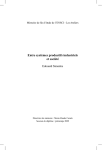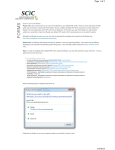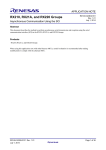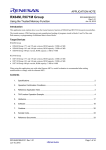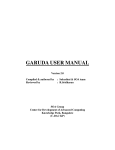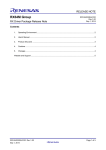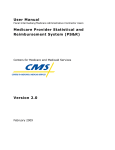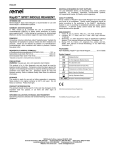Download RX63N Group, RX631 Group
Transcript
APPLICATION NOTE RX63N Group, RX631 Group Clock Synchronous SCIc Communication Using the DMACA R01AN1064EJ0100 Rev.1.00 Apr. 05, 2013 Abstract This application note describes a method for clock synchronous serial communication using the RX63N and RX631’s DMA controller (DMAC) and serial communication interface (SCI) Products • • • • • • RX63N Group, 177- and 176-pin versions, ROM capacity: 768 KB to 2 MB RX63N Group, 145- and 144-pin versions, ROM capacity: 768 KB to 2 MB RX63N Group, 100-pin version, ROM capacity: 768 KB to 2 MB RX631 Group, 177- and 176-pin versions, ROM capacity: 256 KB to 2 MB RX631 Group, 145- and 144-pin versions, ROM capacity: 256 KB to 2 MB RX631 Group, 100-pin version, ROM capacity: 256 KB to 2 MB When using this application note with other Renesas MCUs, careful evaluation is recommended after making modifications to comply with the alternate MCU. R01AN1064EJ0100 Rev.1.00 Apr. 05, 2013 Page 1 of 26 RX63N Group, RX631 Group Clock Synchronous SCIc Communication Using the DMACA Contents 1. Specifications ..................................................................................................................................... 3 2. Operation Confirmation Conditions .................................................................................................... 4 3. Reference Application Note ................................................................................................................ 4 4. Hardware ............................................................................................................................................ 5 4.1 Hardware Configuration ............................................................................................................... 5 4.2 Pins Used ..................................................................................................................................... 5 5. Software ............................................................................................................................................. 6 5.1 Operational Overview .................................................................................................................. 7 5.1.1 Transmit Operation ............................................................................................................... 7 5.1.2 Reception Operation ............................................................................................................. 9 5.2 File Composition ........................................................................................................................ 11 5.3 Option-Setting Memory .............................................................................................................. 11 5.4 Constants ................................................................................................................................... 12 5.5 Variable ...................................................................................................................................... 12 5.6 Functions.................................................................................................................................... 13 5.7 Function Specifications .............................................................................................................. 14 5.8 Flowcharts .................................................................................................................................. 17 5.8.1 Main Processing ................................................................................................................. 17 5.8.2 Port Initialization ................................................................................................................. 18 5.8.3 Peripheral Function Initialization ......................................................................................... 19 5.8.4 SCI9 Initialization ................................................................................................................ 20 5.8.5 DMAC0 Initialization ........................................................................................................... 21 5.8.6 DMAC1 Initialization ........................................................................................................... 22 5.8.7 SCI9 Transmission and Reception Start ............................................................................ 23 5.8.8 DMAC0 Transfer Complete Interrupt Handler .................................................................... 24 5.8.9 DMAC1 Transfer Complete Interrupt Handler .................................................................... 24 5.8.10 SCI9 Transmission Complete Interrupt Handler ............................................................... 25 5.8.11 Group 12 Interrupt Handler (SCI9 Reception Error Interrupt) ........................................... 25 6. Sample Code .................................................................................................................................... 26 7. Reference Documents ...................................................................................................................... 26 R01AN1064EJ0100 Rev.1.00 Apr. 05, 2013 Page 2 of 26 RX63N Group, RX631 Group 1. Clock Synchronous SCIc Communication Using the DMACA Specifications This sample program performs clock synchronous serial transmission and reception using the SCI module. The transmit data is stored in advance in a RAM transmit data storage area and is transferred using a DMAC. The receive data is transferred to the RAM receive data storage area using a DMAC. Serial communication is started when a falling edge is detected on the interrupt request pin (IRQ15). • • • • Transfer rate: 38,400 bps Communication format: 8 bits, LSB first Clock input/output: Clock output (master) Transmission/reception operation: Transmission and reception can be performed at the same time. Table 1.1 lists the peripheral function used and their applications and figure 1.1 shows the block diagram. Table 1.1 Peripheral Functions and Their Applications Peripheral Function SCIc channel 9 (SCI9) DMACA channel 0 (DMAC0) DMACA channel 1 (DMAC1) IRQ15 Application Clock synchronous serial transmission and reception Transfer of SCI receive data to RAM Transfer of RAM transmit data to the SCI module Start trigger for serial transmission or reception Internal RAM Receive data Receive data storage area Data transfer DMAC0 Transmit data Transmit data storage area Data transfer DMAC1 SCI TXI RXI IRQ15 CPU Transmit enable/ receive enable Transmit block TXD9 Receive block RXD9 Clock SCK9 Figure 1.1 Block Diagram R01AN1064EJ0100 Rev.1.00 Apr. 05, 2013 Page 3 of 26 RX63N Group, RX631 Group 2. Clock Synchronous SCIc Communication Using the DMACA Operation Confirmation Conditions The sample code accompanying this application note has been run and confirmed under the conditions below. Table 2.1 Operation Confirmation Conditions Item Microcontroller used Operating frequency Operating voltage Integrated development environment C compiler iodefine.h version Endian order Operating mode Processor mode Sample code version Board used 3. Description R5F563NBDDFC (RX63N Group) Main clock: 12 MHz PLL: 192 MHz (Main clock divided by 1 and multiplied by 16) System clock (ICLK): 96 MHz (PLL divided by 2) Peripheral module clock B (PCLKB): 48 MHz (PLL divided by 4) 3.3 V Renesas Electronics Corporation High-performance Embedded Workshop Version 4.09.01 Renesas Electronics Corporation C/C++ Compiler Package for RX Family V.1.02 Release 01 Compiler options -cpu=rx600 -output=obj="$(CONFIGDIR)\$(FILELEAF).obj" -debug -nologo (The integrated development environment default settings are used.) Version 1.50 Little-endian Single-chip mode Supervisor mode Version 1.00 Renesas Starter Kit+ for RX63N (Product number: R0K50563NC000BE) Reference Application Note For additional information associated with this document, refer to the following application note. • RX63N Group, RX631 Group Initial Setting Rev.1.00 (R01AN1245EJ0100_RX63N) The initialization functions from the above application note are used by the sample code in this application note. The revision number shown is the one used when this application note was written. If there is a more recent version, use the latest version. Check the Renesas Electronics Corporation web site to verify and download the latest version. R01AN1064EJ0100 Rev.1.00 Apr. 05, 2013 Page 4 of 26 RX63N Group, RX631 Group 4. 4.1 Clock Synchronous SCIc Communication Using the DMACA Hardware Hardware Configuration Figure 4.1 shows a connection example. RX63N group Switch input (SW input) P07/IRQ15 Communication device SCK9 CLK TXD9 RXD RXD9 TXD Figure 4.1 Connection Example 4.2 Pins Used Table 4.1 lists the pins used and their functions. Table 4.1 Pins Used and Their Functions Pin Name P07/IRQ15 PB5/SCK9 PB6/RXD9 PB7/TXD9 I/O Input Output Input Output R01AN1064EJ0100 Rev.1.00 Apr. 05, 2013 Function Transmit/receive start switch input SCI9 clock output SCI9 receive data input SCI9 transmit data output Page 5 of 26 RX63N Group, RX631 Group 5. Clock Synchronous SCIc Communication Using the DMACA Software This sample code implements automatic SCI transmission and reception operations by using the DMAC. When the transmit/receive start switch is pressed a SCI transmit/receive operation is started. If transmission is enabled and a TXI9 interrupt request occurs, it functions as a DMAC1 transfer request. DMAC1 transfers data in the transmit data storage area to the TDR register and that data is transmitted. If a reception completes, an RXI9 interrupt request is generated and it functions as a DMAC0 transfer request. DMAC0 is used to transfer the receive data to the receive data storage area. When the transfer of transmit data has been performed 256 times, a DMAC1 interrupt is generated. This disables the TXI9 interrupt and enables the TEI9 interrupt. When the transfer of receive data has been performed 256 times, a DMAC0 interrupt is generated. This disables the RXI9 interrupt and sets the reception complete flag to 1. If the transmission complete flag is 1 at this time, SCI transmit/receive operations are disabled. When 256 bytes of transmissions and 256 bytes of receptions have been completed, a TEI9 interrupt is generated. This disables the TEI9 interrupt and sets the transmission complete flag to 1. If the reception complete flag is 1 at this time, SCI transmit/receive operations are disabled. The settings of the peripheral functions are listed below. SCI9 • • • • • • • • Communication mode: SCK9 pin: Clock source: Transfer rate: Transmit operation: Receive operation: Data transfer direction: Interrupts used: Clock synchronous Internal clock output (master) PCLKB/4 38,400 bps (BRR register setting = (PCLKB/(8×2×38,400 bps)) -1) Enabled Enabled LSB first Transmission complete interrupt (TEI9) Transmit data empty interrupt (TXI9) Receive data full interrupt (RXI9) Receive error interrupt (ERI9) DMAC0 • Start factor: • • • • • • • • RXI9 interrupt request The IR flag for the RXI9 interrupt is cleared to 0 at the start of transfer. Transfer source address: SCI9.RDR register Transfer source address update mode: Fixed address Transfer destination address: RAM (start address of the receive data storage area) Transfer destination address update mode: Increment Transfer mode: Normal mode Data transfer size: 8 bits Transfer count: 256 transfers Interrupts used: Transfer complete interrupt (DMAC0I) R01AN1064EJ0100 Rev.1.00 Apr. 05, 2013 Page 6 of 26 RX63N Group, RX631 Group Clock Synchronous SCIc Communication Using the DMACA DMAC1 • Start factor: • • • • • • • • TXI9 interrupt request The IR flag for the TXI9 interrupt is cleared to 0 at the start of transfer. Transfer source address: RAM (start address of the transmit data storage area) Transfer source address update mode: Increment Transfer destination address: SCI9.TDR register Transfer destination address update mode: Fixed address Transfer mode: Normal mode Data transfer size: 8 bits Transfer count: 256 transfers Interrupts used: Transfer complete interrupt (DMAC1I) IRQ15 input pin • Detection method: • Digital filter: • Interrupts used: 5.1 5.1.1 Falling edge detection Enabled (sampling clock: PCLKB/8) None Operational Overview Transmit Operation (1) Initialization After initialization, the sample code waits for a transmit/receive start switch input. (2) Transmit/receive start switch input detection When a transmit/receive start switch input is detected, the IRQ15 interrupt IR flag is set to 0. After verifying that transmission and reception have completed by checking the transmission complete flag and the reception complete flag, the transmission complete flag is set to 0 (transmission in progress). The DMAC1 transfer source address and transfer count are set and DMA transfers are enabled. The SCI9.SCR.TEIE, TIE, RIE, TE, and RE bits are all set to 1 at the same time to enable transmission and reception operations. The TXI9 interrupt IR flag is set to 1 by the SCI9.TCR.TIE and TE bits being set to 1 at the same time. (3) Data transfer start When the TXI9 interrupt is enabled, DMAC1 is started and the TXI9 interrupt IR flag is set to 0. The first byte of transmit data is transferred from the RAM transmit data storage area to the SCI9.TSR register. (4) Data transmission start Data is transferred from the SCI9.TDR register to the SCI9.TSR register, the TXI9 interrupt IR flag is set to 1, and the first byte of transmit data is output from the TXD9 pin. DMAC1 is started by the TXI9 interrupt request and the second byte of transmit data is transferred. (5) DMAC1I interrupt When the 256th data transfer completes, a DMAC1I interrupt request is generated. The TXI9 interrupt is disabled and the TEI9 interrupt is enabled during DMAC1I interrupt handling. (6) TEI9 interrupt Since the SCI9.TDR register is not updated when the last bit of the 256th byte is transmitted, a TEI9 interrupt request is generated. During TEI9 interrupt handling, the TEI9 interrupt is disabled and the transmission complete flag is set to 1 (transmission complete). If the reception complete flag is 1 (reception complete), transmission and reception are disabled. Execution is then repeated from step (2) above. Figure 5.1 shows the timing chart for the transmission operation. R01AN1064EJ0100 Rev.1.00 Apr. 05, 2013 Page 7 of 26 RX63N Group, RX631 Group Clock Synchronous SCIc Communication Using the DMACA (3) (1) (2) (4) (5) (6) “H” Transmit/receive start switch input pin “L” “1” IRQ15 interrupt IR flag “0” Transmission complete flag “1” “0” “1” SCI9.SCR.TE bit “0” “1” SCI9.SCR.TIE bit “0” “1” SCI9.SCR.TEIE bit “0” DMAC1.DMCNT. DTE bit “1” DMAC1I interrupt IR flag “1” Set to 0 after 256 DMA transfers complete “0” Set to 0 by the acceptance of the interrupt “0” “1” TEI9 interrupt IEN bit “0” “1” TEI9 interrupt IR flag “0” “1” TXI9 interrupt IEN bit Set to 0 when a DMA transfer starts “0” Not set to 1 here because the SCI9.SCR.TIE bit is 0. “1” TXI9 interrupt IR flag “0” RAM→TDR (DMA transfer) SCI9.TDR register FFh 00h 01h 02h FFh FEh TDR→TSR (automatic transfer) SCI9.TSR register Undefined Transmit data output from TXD9 pin 00h 01h ... FEh 00h 01h ... FEh FFh FFh Transmission of 256 bytes Figure 5.1 Transmission Operation Timing Chart R01AN1064EJ0100 Rev.1.00 Apr. 05, 2013 Page 8 of 26 RX63N Group, RX631 Group 5.1.2 Clock Synchronous SCIc Communication Using the DMACA Reception Operation (1) Initialization After initialization, the sample code waits for a transmit/receive start switch input. (2) Transmit/receive start switch input detection When a transmit/receive start switch input is detected, the IRQ15 interrupt IR flag is set to 0. After verifying that transmission and reception have completed by checking the transmission complete flag and the reception complete flag, the reception complete flag is set to 0 (reception in progress). The DMAC0 transfer destination address and transfer count are set and DMA transfers are enabled. The SCI9.SCR.TEIE, TIE, RIE, TE, and RE bits are all set to 1 at the same time to enable transmission and reception operations and the RXI9 interrupt. (3) Data reception completion When reception of the first byte of data completes, the data is transferred from the SCI9.RSR register to the SCI9.RDR register and the RXI9 interrupt IR flag is set to 1. (4) Data transfer start DMAC0 is started by the RXI9 interrupt request and the RXI9 interrupt IR flag is cleared to 0. The first byte of receive data is transferred from the SCI9.RDR register to the RAM receive data storage area. (5) DMAC0I interrupt When the 256th data transfer completes, a DMAC0I interrupt request is generated. During DMAC0I interrupt handling, the RXI9 interrupt is disabled and the reception complete flag is set to 1 (reception complete). If the transmission complete flag is 1 (transmission complete), transmission and reception are disabled. Execution is then repeated from step (2) above. Figure 5.2 shows the timing chart for the transmission operation. R01AN1064EJ0100 Rev.1.00 Apr. 05, 2013 Page 9 of 26 RX63N Group, RX631 Group Clock Synchronous SCIc Communication Using the DMACA (4) (1) Transmit/receive start switch input pin (2) (5) (3) “H” “L” “1” IRQ15 interrupt IR flag “0” “1” Reception complete flag “0” “1” SCI9.SCR.RIE bit “0” “1” SCI9.SCR.RE bit “0” DMAC0.DMCNT. DTE bit “1” DMAC0I interrupt IR flag “1” Set to 0 after 256 DMA transfers complete “0” Set to 0 by the acceptance of the interrupt “0” “1” RXI9 interrupt IEN bit Set to 0 when a DMA transfer starts “0” “1” RXI9 interrupt IR flag “0” RDR→RAM (DMA transfer) SCI9.RDR register 00h data0 data1 data0 data1 ... data0 data1 ... data254 data255 RSR→RDR (automatic transfer) SCI9.RSR register Undefined Receive data input to the RXD9 pin data255 data255 Reception of 256 bytes Figure 5.2 Reception Operation Timing Chart R01AN1064EJ0100 Rev.1.00 Apr. 05, 2013 Page 10 of 26 RX63N Group, RX631 Group Clock Synchronous SCIc Communication Using the DMACA Notes on Embedding the Sample Code in the User System When embedding the sample code from this application note in the actual system, note the following: • When operating in slave mode, if the interrupts used in this application are forced to wait for extended periods due to, for example, the handling of other interrupts, this code may not operate correctly. 5.2 File Composition Table 5.1 lists the files used in the sample code. Files generated by the integrated development environment are not included in this table. Table 5.1 Files Used in the Sample Code File Name main.c r_init_stop_module.c r_init_stop_module.h r_init_non_existent_port.c r_init_non_existent_port.h r_init_clock.c r_init_clock.h 5.3 Outline Main processing Stops peripheral modules that are operating after a reset Header file for r_init_stop_module.c Initialization for ports that do not exist Header file for r_init_non_existent_port.c Initialization for clock Header file for r_init_clock.c Remarks Option-Setting Memory Table 5.2 lists the option-setting memory configured in the sample code. When necessary, set a value suited to the user system. Table 5.2 Option-Setting Memory Configured in the Sample Code Symbol OFS0 Address FFFF FF8Fh to FFFF FF8Ch Setting Value FFFF FFFFh OFS1 FFFF FF8Bh to FFFF FF88h FFFF FFFFh MDES FFFF FF83h to FFFF FF80h FFFF FFFFh R01AN1064EJ0100 Rev.1.00 Apr. 05, 2013 Contents Stops IWDT after a reset Stops WDT after a reset Disables voltage monitoring 0 resets after a reset Disables HOCO oscillation after a reset Little-endian Page 11 of 26 RX63N Group, RX631 Group 5.4 Clock Synchronous SCIc Communication Using the DMACA Constants Table 5.3 lists the constants used in the sample code. Table 5.3 Constants Used in the Sample Code Constant Name MASTER SLAVE SCI_CLK BUF_SIZE DMAC_CNT SW_ON SW_OFF 5.5 Setting Value 00h 02h MASTER 256 BUF_SIZE 1 0 Contents Set value of the SCI9.SCR.CKE[1:0] bits: Internal clock (master) Set value of the SCI9.SCR.CKE[1:0] bits: External clock (slave) Set value of the SCI9.SCR.CKE[1:0] bits: Master mode selected Size of the transmission and reception data storage areas DMAC transfer count Switch input on state Switch input off state Variable Table 5.4 lists the global variables. Table 5.4 Global Variables Type unsigned char Variable Name rcv_end_flag unsigned char trn_end_flag unsigned char rcvbuf[BUF_SIZE] Contents Reception complete flag 0: Reception in progress 1: Reception complete Transmission complete flag 0: Transmission in progress 1: Transmission complete Receive data storage area unsigned char trnbuf[BUF_SIZE] Transmit data storage area R01AN1064EJ0100 Rev.1.00 Apr. 05, 2013 Function Used main Excep_DMAC_DMAC0I Excep_SCI9_TEI9 main Excep_DMAC_DMAC0I Excep_SCI9_TEI9 dmac0_init sci9_start main dmac1_init sci9_start Page 12 of 26 RX63N Group, RX631 Group 5.6 Clock Synchronous SCIc Communication Using the DMACA Functions Table 5.5 lists the functions used in the sample code. Table 5.5 Functions Used in the Sample Code Function Name main port_init R_INIT_StopModule R_INIT_NonExistentPort R_INIT_Clock peripheral_init sci9_init dmac0_init dmac1_init sci9_start Excep_DMAC_DMAC0I Excep_DMAC_DMAC1I Excep_SCI9_TEI9 Excep_ICU_GROUP12 R01AN1064EJ0100 Rev.1.00 Apr. 05, 2013 Outline Main processing Port initialization Stop processing for active peripheral functions after a reset Nonexistent port initialization Clock initialization Peripheral function initialization SCI9 initialization DMAC0 initialization DMAC1 initialization Starts SCI9 transmission and reception DMAC0 transfer complete interrupt handler DMAC1 transfer complete interrupt handler SCI9 transmission complete interrupt handler Group 12 interrupt handler (SCI9 receive error interrupt) Page 13 of 26 RX63N Group, RX631 Group 5.7 Clock Synchronous SCIc Communication Using the DMACA Function Specifications The following tables list the sample code function specifications. main Outline Header Declaration Description Arguments Return Value port_init Outline Header Declaration Description Arguments Return Value R_INIT_StopModule Outline Header Declaration Description Arguments Return Value Remarks Main processing None void main(void) After initialization, this function starts SCI9 transmission and reception operations when a transmit/receive start switch input is detected. None None Port initialization None void port_init(void) Initializes the ports. None None Stop processing for active peripheral functions after a reset r_init_stop_module.h void R_INIT_StopModule(void) Configures the setting to enter the module-stop state. None None Transition to the module-stop state is not performed in the sample code. Refer to the RX63N Group, RX631 Group Initial Setting Rev. 1.00 application note for details of this function. R_INIT_NonExistentPort Nonexistent port initialization Outline r_init_non_existent_port.h Header void R_INIT_NonExistentPort(void) Declaration Initializes port direction registers for ports that does not exist in products with less Description than 176 pins. None Arguments None Return Value The number of pins in the sample code is set for the 176-pin package Remarks (PIN_SIZE=176). After this function is called, when writing in byte units to the PDR registers or PODR registers which have nonexistent ports, set the corresponding bits for nonexistent ports as follows: set the I/O select bits in the PDR registers to 1 and set the output data store bits in the PODR registers to 0. Refer to the RX63N Group, RX631 Group Initial Setting Rev. 1.00 application note for details of this function. R01AN1064EJ0100 Rev.1.00 Apr. 05, 2013 Page 14 of 26 RX63N Group, RX631 Group R_INIT_Clock Outline Header Declaration Description Arguments Return Value Remarks Clock Synchronous SCIc Communication Using the DMACA Clock initialization r_init_clock.h void R_INIT_Clock(void) Initializes the clock. None None The sample code selects processing which uses PLL as the system clock without using the sub-clock. Refer to the RX63N Group, RX631 Group Initial Setting Rev. 1.00 application note for details of this function. peripheral_init Outline Header Declaration Description Arguments Return Value Peripheral function initialization None void peripheral_init(void) Initializes the peripheral functions used. None None sci9_init Outline Header Declaration Description Arguments Return Value SCI9 initialization None void sci9_init(void) Initializes SCI9. None None dmac0_init Outline Header Declaration Description Arguments Return Value DMAC0 initialization None void dmac0_init(void) Initializes DMAC0. None None dmac1_init Outline Header Declaration Description Arguments Return Value DMAC1 initialization None void dmac1_init(void) Initializes DMAC1. None None R01AN1064EJ0100 Rev.1.00 Apr. 05, 2013 Page 15 of 26 RX63N Group, RX631 Group sci9_start Outline Header Declaration Description Arguments Return Value Clock Synchronous SCIc Communication Using the DMACA Starts SCI9 transmission and reception None void sci9_start(void) Starts the SCI9 transmission and reception operation. None None Excep_DMAC_DMAC0I DMAC0 transfer complete interrupt handler Outline None Header void Excep_DMAC_DMAC0I(void) Declaration Disables the RXI9 interrupt and sets the reception complete flag. If the transmission Description complete flag is 1, it disables SCI9 transmission and reception. None Arguments None Return Value Excep_DMAC_DMAC1I DMAC1 transfer complete interrupt handler Outline None Header void Excep_DMAC_DMAC1I(void) Declaration Disables the TXI9 interrupt and enables the TEI9 interrupt. Description None Arguments None Return Value Excep_SCI9_TEI9 Outline Header Declaration Description Arguments Return Value SCI9 transmission complete interrupt handler None void Excep_SCI9_TEI9(void) Disables the TEI9 interrupt and sets the transmission complete flag. If the reception complete flag is 1, it disables SCI9 transmission and reception. None None Excep_ICU_GROUP12 Group 12 interrupt handler (SCI9 receive error interrupt) Outline None Header void Excep_ICU_GROUP12 (void) Declaration Handles group 12 interrupts (SCI9 receive error interrupt). Description None Arguments None Return Value This sample code does not perform the SCI9 receive error handling; it simply Remarks executes an infinite loop. Add a program if required. R01AN1064EJ0100 Rev.1.00 Apr. 05, 2013 Page 16 of 26 RX63N Group, RX631 Group 5.8 5.8.1 Clock Synchronous SCIc Communication Using the DMACA Flowcharts Main Processing Figure 5.3 shows the flowchart for the main processing. main Disable maskable interrupts I flag ← 0 Initialize ports port_init() After a reset, stop operating peripheral functions R_INIT_StopModule() Initialize nonexistent ports R_INIT_NonExistentPort() Initialize clocks R_INIT_Clock() Initialize peripheral functions peripheral_init() Enable maskable interrupts I flag ← 1 Store transmit data in RAM trnbuf[0] to trnbuf[255] ← 00h to FFh Set transmission and reception complete flags No Transmit/receive start switch input? trn_end_flag ← 1 rcv_end_flag ← 1 Reads the IR079 register IR flag Yes Clear IRQ15 interrupt request Wait for transmission and reception complete :0 :No IRQ15 interrupt request :1 :There is an IRQ15 interrupt request IR079 register IR flag ← 0 Reads the trn_end_flag Reads the rcv_end_flag Clear transmission and reception complete flags :Transmission complete :Reception complete trn_end_flag ← 0 rcv_end_flag ← 0 :0 :Transmission in progress :1 :Transmission complete :0 :Reception in progress :1 :Reception complete :Transmission in progress :Reception in progress Start SCI9 transmission and reception sci9_start() Figure 5.3 Main Processing R01AN1064EJ0100 Rev.1.00 Apr. 05, 2013 Page 17 of 26 RX63N Group, RX631 Group 5.8.2 Clock Synchronous SCIc Communication Using the DMACA Port Initialization Figure 5.4 shows the flowchart for the port initialization. port_init Set port output data Set port direction Set port mode PORTB.PODR register B7 bit ← 1 PORT0.PDR register B7 bit ← 0 PORTB.PDR register B5 bit ← 0 B6 bit ← 0 B7 bit ← 1 PORT3.PMR register B2 bit ← 0 PORTB.PMR register B5 bit ← 0 B6 bit ← 0 B7 bit ← 0 :PB7/TXD9 :High-level output :P07/IRQ15 :Input :PB5/SCK9 :Input :PB6/RXD9 :Input :PB7/TXD9 :Output :P07/IRQ15 :Used as a general-purpose I/O port :PB5/SCK9 :Used as a general-purpose I/O port :PB6/RXD9 :Used as a general-purpose I/O port :PB7/TXD9 :Used as a general-purpose I/O port return Figure 5.4 Port Initialization R01AN1064EJ0100 Rev.1.00 Apr. 05, 2013 Page 18 of 26 RX63N Group, RX631 Group 5.8.3 Clock Synchronous SCIc Communication Using the DMACA Peripheral Function Initialization Figure 5.5 shows the flowchart for the peripheral function initialization. peripheral_init Enable writing to related registers PRCR register ← A502h PRC1 bit = 1 Clear module stop state MSTPCRC register MSTPC26 bit ← 0 :Clears the SCI9 module stop state. Clear module stop state MSTPCRA register MSTPA28 bit ← 0 :Clears the DMAC module stop state. Disable writing to related registers PRCR register ← A500h PRC1 bit = 0 Initialize SCI9 sci9_init() Initialize DMAC0 dmac0_init() Initialize DMAC1 dmac1_init() Enable DMAC start Disable IRQ15 interrupt request Disable IRQ15 digital filter Set up IRQ15 sampling clock Set IRQ15 port DMAST register ← 01h DMST bit = 1 IER09 register IEN7 bit ← 0 IRQFLTE1 register FLTEN15 bit ← 0 IRQFLTC1 register FCLKSEL15[1:0] bits ← 01b PWPR register B0WI bit ← 0 PWPR register PFSWE bit ← 1 P07PFS register ISEL bit ← 1 PWPR register PFSWE bit ← 0 PWPR register B0WI bit ← 1 Set IRQ15 detection method IRQCR15 register ← 04h IRQMD[1:0] bits = 01b Clear IRQ15 interrupt request IR079 register IR flag ← 0 Enable IRQ15 digital filter :PCLKB/8 :Enables writing the PFSWE bit. :Enables writing the PFS register. :Sets up use as the IRQ15 input pin. :Disables writing the PFS register. :Disables writing the PFSWE bit. :Falling edge IRQFLTE1 register FLTEN15 bit ← 1 return Figure 5.5 Peripheral Function Initialization R01AN1064EJ0100 Rev.1.00 Apr. 05, 2013 Page 19 of 26 RX63N Group, RX631 Group 5.8.4 Clock Synchronous SCIc Communication Using the DMACA SCI9 Initialization Figure 5.6 shows the flowchart for the SCI9 initialization. sci9_init Disable SCI9 interrupt requests IER0E register IEN2 bit ← 0 GEN12 register EN9 bit ← 0 IER1E register IEN1 bit ← 0 IEN2 bit ← 0 IEN3 bit ← 0 Disable transmission, reception, and interrupt requests SCI9.SCR register ← 00h TEIE bit = 0 RE bit = 0 TE bit = 0 RIE bit = 0 TIE bit = 0 Set up I/O port functions PWPR register B0WI bit ← 0 PWPR register PFSWE bit ← 1 PB5PFS register ← 0Ah PSEL[4:0] bits = 01010b PB6PFS register ← 0Ah PSEL[4:0] bits = 01010b PB7PFS register ← 0Ah PSEL[4:0] bits = 01010b PWPR register PFSWE bit ← 0 PWPR register B0WI bit ← 1 PORTB.PMR register B5 bit ← 1 B6 bit ← 1 Select clock Set operating mode Set clock phase and polarity Set transmission and reception formats :Disables ICU.GROUP12 (SCI9.ERI9) interrupt requests. :Disables SCI9.ERI9 (GROUP12) interrupt requests. :Disables SCI9.RXI9 interrupt requests. :Disables SCI9.TXI9 interrupt requests. :Disables SCI9.TEI9 interrupt requests. :Disables TEI interrupt requests. :Disables serial reception operation. :Disables serial transmission operation. :Disables RXI and ERI interrupt requests. :Disables TXI interrupt requests. :Enables writing the PFSWE bit. :Enables writing the PFS register. :PB5 pin function selection :SCK9 :PB6 pin function selection :RXD9 :PB7 pin function selection :TXD9 :Disables writing the PFS register. :Disables writing the PFSWE bit. :PB5/SCK9 :Used as a peripheral function pin. :PB6/RXD9 :Used as a peripheral function pin. SCI9.SCR register CKE[1:0] bits ← SCK_CLK :Internal clock (The SCK9 pin is used as the clock output pin) SCI9.SIMR1 register IICM bit ← 0 :Serial interface mode SCI9.SPMR register CKPH bit ← 0 CKPOL bit ← 0 :No clock phase delay :No clock polarity inversion SCI9.SMR register ← 81h CKS[1:0] bits = 01b :PCLKB/4 CM bit = 1 :Operates in clock synchronous mode. SCI9.SCMR register ← F2h SMIF bit = 0 :Serial communications interface mode SINV bit = 0 :No transmit or receive data inversion SDIR bit = 0 :LSB first Set bit rate SCI9.BRR register ← 77 Set interrupt priority level IPR241 register IPR[3:0] bits ← 0001b IPR114 register IPR[3:0] bits ← 0001b :77.125 = (48 MHz / (8×2×38400 bps)) - 1 :Sets the SCI9.RXI9, TXI9, and TEI9 interrupts to priority level 1. :Sets the ICU.GROUP12(SCI9.ERI9) interrupts to priority level 1. return Figure 5.6 SCI9 Initialization R01AN1064EJ0100 Rev.1.00 Apr. 05, 2013 Page 20 of 26 RX63N Group, RX631 Group 5.8.5 Clock Synchronous SCIc Communication Using the DMACA DMAC0 Initialization Figure 5.7 shows the flowchart for the DMAC0 initialization. dmac0_init Disable DMAC0I interrupt requests Disable DMA transfers Set up start factor Set addressing mode Set transfer mode Set up clear as the start factor Set transfer source address Set transfer destination address Set transfer count Set interrupt priority level Enable transfer complete interrupt Enable DMAC0I interrupt requests Enable DMA transfers IER18 register IEN6 bit ← 0 DMAC0.DMCNT register ← 00h DTE bit = 0 DMRSR0 register ← 241 DMRS[7:0] bits = 11011100b :Sets the DMAC0 start request (RXI9) vector number. DMAC0.DMAMD register ← 0080h DARA[4:0] bits = 00000b DM[1:0] bits = 10b SARA[4:0] bits = 00000b SM[1:0] bits = 00b :Does not set up an extended repeat area. :Increment :Does not set up an extended repeat area. :Fixed address DMAC0.DMTMD register ← 0001h DCTG[1:0] bits = 01b :Peripheral module interrupts SZ[1:0] bits = 00b :8-bit transfers MD[1:0] bits = 00b :Normal transfers DMAC0.DMCSL register ← 00h DISEL bit = 0 :Clears to 0 the interrupt flag that was the start factor at transfer start. DMAC0.DMSAR register ← The address of the SCI9.RDR register DMAC0.DMDAR register ← The address of the rcvbuf[0] DMAC0.DMCRA register ← DMAC_CNT IPR198 register IPR[3:0] bits ← 0001b :Sets the DMAC0I interrupts to priority level 1. DMAC0.DMINT register ← 10h DTIE bit = 1 IER18 register IEN6 bit ← 1 DMAC0.DMCNT register ← 01h DTE bit = 1 return Figure 5.7 DMAC0 Initialization R01AN1064EJ0100 Rev.1.00 Apr. 05, 2013 Page 21 of 26 RX63N Group, RX631 Group 5.8.6 Clock Synchronous SCIc Communication Using the DMACA DMAC1 Initialization Figure 5.8 shows the flowchart for the DMAC1 initialization. dmac1_init Disable DMAC1I interrupt requests Disable DMA transfers Set up start factor Set addressing mode Set transfer mode Set up clear as the start factor Set transfer source address Set transfer destination address Set transfer count Set interrupt priority level Enable transfer complete interrupt Enable DMAC1I interrupt requests Enable DMA transfers IER18 register IEN7 bit ← 0 DMAC1.DMCNT register ← 00h DTE bit = 0 DMRSR1 register ← 242 DMRS[7:0] bits = 11011101b :Sets the DMAC1 start request (TXI9) vector number. DMAC1.DMAMD register ← 8000h DARA[4:0] bits = 00000b DM[1:0] bits = 00b SARA[4:0] bits = 00000b SM[1:0] bits = 10b :Does not set up an extended repeat area. :Fixed address :Does not set up an extended repeat area. :Increment DMAC1.DMTMD register ← 0001h DCTG[1:0] bits = 01b :Peripheral module interrupts SZ[1:0] bits = 00b :8-bit transfers MD[1:0] bits = 00b :Normal transfers DMAC1.DMCSL register ← 00h DISEL bit = 0 :Clears to 0 the interrupt flag that was the start factor at transfer start. DMAC1.DMSAR register ← The address of the trnbuf[0] DMAC1.DMDAR register ← The address of the SCI9.TDR register DMAC1.DMCRA register ← DMAC_CNT IPR199 register IPR[3:0] bits ← 0001b :Sets the DMAC1I interrupts to priority level 1. DMAC1.DMINT register ← 10h DTIE bit = 1 IER18 register IEN7 bit ← 1 DMAC1.DMCNT register ← 01h DTE bit = 1 return Figure 5.8 DMAC1 Initialization R01AN1064EJ0100 Rev.1.00 Apr. 05, 2013 Page 22 of 26 RX63N Group, RX631 Group 5.8.7 Clock Synchronous SCIc Communication Using the DMACA SCI9 Transmission and Reception Start Figure 5.9 shows the flowchart for the SCI9 transmission and reception start. sci9_start Set DMAC0 transfer destination address Set DMAC0 transfer count Enable DMA transfers DMAC0.DMDAR register ← The address of the rcvbuf[0] DMAC0.DMCRA register ← DMAC_CNT DMAC0.DMCNT register ← 01h DTE bit = 1 Set DMAC1 transfer source address DMAC1.DMSAR register ← The address of the trnbuf[0] Set DMAC1 transfer count DMAC1.DMCRA register ← DMAC_CNT Enable DMA transfers Start SCI9 transmission and reception DMAC1.DMCNT register ← 01h DTE bit = 1 SCI9.SCR register ← SCI9.SCR register | F4h TEIE bit = 1 :Enables TEI interrupt requests. RE bit = 1 :Enables serial reception operation. TE bit = 1 :Enables serial transmission operation. RIE bit = 1 :Enables RXI and ERI interrupt requests. TIE bit = 1 :Enables TXI interrupt requests. PORTB.PMR register B7 bit ← 1 :PB7/TXD9: Used as a peripheral function pin. Enable ERI9 interrupt request GEN12 register EN9 bit ← 1 :Enables SCI9.ERI9 (GROUP12) interrupt requests. Enable GROUP12 interrupt request IER0E register IEN2 bit ← 1 :Enables ICU.GROUP12 (SCI9.ERI9) interrupt requests. Enable RXI9 interrupt request IER1E register IEN1 bit ← 1 :Enables SCI9.RXI9 interrupt requests. Enable TXI9 interrupt request IER1E register IEN2 bit ← 1 :Enables SCI9.TXI9 interrupt requests. Set up I/O port functions return Figure 5.9 SCI9 Transmission and Reception Start R01AN1064EJ0100 Rev.1.00 Apr. 05, 2013 Page 23 of 26 RX63N Group, RX631 Group 5.8.8 Clock Synchronous SCIc Communication Using the DMACA DMAC0 Transfer Complete Interrupt Handler Figure 5.10 shows the flowchart for the DMAC0 transfer complete interrupt handler. Excep_DMAC_DMAC0I IER1E register IEN1 bit ← 0 :Disables SCI9.RXI9 interrupt requests. Disable interrupt requests*1 SCI9.SCR register RIE bit ← 0 :Disables RXI and ERI interrupt requests. Clear RXI9 interrupt request IR241 register IR flag ← 0 :No SCI9.RXI9 interrupt requests. Set reception complete flag rcv_end_flag ← 1 :Reception complete Reads out trn_end_flg. :0 :Transmission in progress :1 :Transmission complete Disable RXI9 interrupt request No Transmission complete? Yes Set I/O port functions Disable SCI9 transmission and reception PORTB.PMR register B7 bit ← 0 :PB7/TXD9 :Used as general-purpose I/O ports. SCI9.SCR register ← SCI9.SCR register & 03h TEIE bit = 0 :Disables TEI interrupt requests. RE bit = 0 :Disables serial reception operation. TE bit = 0 :Disables serial transmission operation. RIE bit = 0 :Disables RXI and ERI interrupt requests. TIE bit = 0 :Disables TXI interrupt requests. return Note: 1. After writing a value to the RIE bit, verify that the written value can be read. Figure 5.10 DMAC0 Transfer Complete Interrupt Handler 5.8.9 DMAC1 Transfer Complete Interrupt Handler Figure 5.11 shows the flowchart for the DMAC1 transfer complete interrupt handler. Excep_DMAC_DMAC1I IER1E register IEN2 bit ← 0 :Disables SCI9.TXI9 interrupt requests. Disable interrupt requests*1 SCI9.SCR register TIE bit ← 0 :Disables TXI interrupt requests. Clear TXI9 interrupt request IR242 register IR flag ← 0 :No SCI9.TXI9 interrupt requests. Enable TEI9 interrupt requests IER1E register IEN3 bit ← 1 :Enables the SCI9.TEI9 interrupt request. Disable TXI9 interrupt request return Note: 1. After writing a value to the TIE bit, verify that the written value can be read. Figure 5.11 DMAC1 Transfer Complete Interrupt Handler R01AN1064EJ0100 Rev.1.00 Apr. 05, 2013 Page 24 of 26 RX63N Group, RX631 Group 5.8.10 Clock Synchronous SCIc Communication Using the DMACA SCI9 Transmission Complete Interrupt Handler Figure 5.12 shows the flowchart for the SCI9 transmission complete interrupt handler. Excep_SCI9_TEI9 An interrupt occurred Check the source of the interrupt request No interrupt occurred Reads the SCI9.SCR register. TEIE bit :0 :Disables TEI interrupt request :1 :Enables TEI interrupt request Reads the SCI9.SSR register. TEND flag :0 :Character transmission in progress :1 :Character transmission completed IER1E register IEN3 bit ← 0 :Disables SCI9.TEI9 interrupt requests. Disable interrupt requests*1 SCI9.SCR register TEIE bit ← 0 :Disables TEI interrupt requests. Set transmission complete flag trn_end_flag ← 1 :Transmission completed. Disable TEI9 interrupt requests No Reception complete? Reads the rcv_end_flag :0 :Reception in progress :1 :Reception completed Yes Set I/O port functions Disable SCI9 transmission and reception PORTB.PMR register B7 bit ← 0 :Used as the PB7/TXD9 general-purpose I/O port. SCI9.SCR register ← SCI9.SCR register & 03h TEIE bit = 0 :Disables TEI interrupt requests. RE bit = 0 :Disables serial reception operation. TE bit = 0 :Disables serial transmission operation. RIE bit = 0 :Disables RXI and ERI interrupt requests. TIE bit = 0 :Disables TXI interrupt requests. IR = 1 Check IR flag IR = 0 Reads the IR243 register IR flag :0 :No interrupt request occurred :1 :An interrupt request occurred return Note: 1. After writing a value to the TEIE bit, verify that the written value can be read. Figure 5.12 SCI9 Transmission Complete Interrupt Handler 5.8.11 Group 12 Interrupt Handler (SCI9 Reception Error Interrupt) Figure 5.13 shows the flowchart for the Group 12 interrupt handler (SCI9 reception error interrupt). Excep_ICU_GROUP12 Handle SCI9 reception error This sample code does not perform the SCI9 receive error handling; it simply executes an infinite loop. Add a program if required. return Figure 5.13 Group 12 Interrupt Handler (SCI9 Reception Error Interrupt) R01AN1064EJ0100 Rev.1.00 Apr. 05, 2013 Page 25 of 26 RX63N Group, RX631 Group 6. Clock Synchronous SCIc Communication Using the DMACA Sample Code Sample code can be downloaded from the Renesas Electronics website. 7. Reference Documents User’s Manual: Hardware RX63N Group, RX631 Group User’s Manual: Hardware Rev.1.50 (R01UH0041EJ) The latest version can be downloaded from the Renesas Electronics website. Technical Update/Technical News The latest information can be downloaded from the Renesas Electronics website. User’s Manual: Development Tools RX Family C/C++ Compiler Package V.1.01 User’s Manual Rev.1.00 (R20UT0570EJ) The latest version can be downloaded from the Renesas Electronics website. Website and Support Renesas Electronics website http://www.renesas.com Inquiries http://www.renesas.com/contact/ R01AN1064EJ0100 Rev.1.00 Apr. 05, 2013 Page 26 of 26 REVISION HISTORY Rev. Date 1.00 Apr. 05, 2013 RX63N Group, RX631 Group Application Note Clock Synchronous SCIc Communication Using the DMACA Page — Description Summary First edition issued All trademarks and registered trademarks are the property of their respective owners. A-1 General Precautions in the Handling of MPU/MCU Products The following usage notes are applicable to all MPU/MCU products from Renesas. For detailed usage notes on the products covered by this document, refer to the relevant sections of the document as well as any technical updates that have been issued for the products. 1. Handling of Unused Pins Handle unused pins in accord with the directions given under Handling of Unused Pins in the manual. ⎯ The input pins of CMOS products are generally in the high-impedance state. In operation with an unused pin in the open-circuit state, extra electromagnetic noise is induced in the vicinity of LSI, an associated shoot-through current flows internally, and malfunctions occur due to the false recognition of the pin state as an input signal become possible. Unused pins should be handled as described under Handling of Unused Pins in the manual. 2. Processing at Power-on The state of the product is undefined at the moment when power is supplied. ⎯ The states of internal circuits in the LSI are indeterminate and the states of register settings and pins are undefined at the moment when power is supplied. In a finished product where the reset signal is applied to the external reset pin, the states of pins are not guaranteed from the moment when power is supplied until the reset process is completed. In a similar way, the states of pins in a product that is reset by an on-chip power-on reset function are not guaranteed from the moment when power is supplied until the power reaches the level at which resetting has been specified. 3. Prohibition of Access to Reserved Addresses Access to reserved addresses is prohibited. ⎯ The reserved addresses are provided for the possible future expansion of functions. Do not access these addresses; the correct operation of LSI is not guaranteed if they are accessed. 4. Clock Signals After applying a reset, only release the reset line after the operating clock signal has become stable. When switching the clock signal during program execution, wait until the target clock signal has stabilized. ⎯ When the clock signal is generated with an external resonator (or from an external oscillator) during a reset, ensure that the reset line is only released after full stabilization of the clock signal. Moreover, when switching to a clock signal produced with an external resonator (or by an external oscillator) while program execution is in progress, wait until the target clock signal is stable. 5. Differences between Products Before changing from one product to another, i.e. to a product with a different part number, confirm that the change will not lead to problems. ⎯ The characteristics of an MPU or MCU in the same group but having a different part number may differ in terms of the internal memory capacity, layout pattern, and other factors, which can affect the ranges of electrical characteristics, such as characteristic values, operating margins, immunity to noise, and amount of radiated noise. When changing to a product with a different part number, implement a system-evaluation test for the given product. Notice 1. Descriptions of circuits, software and other related information in this document are provided only to illustrate the operation of semiconductor products and application examples. You are fully responsible for the incorporation of these circuits, software, and information in the design of your equipment. Renesas Electronics assumes no responsibility for any losses incurred by you or third parties arising from the use of these circuits, software, or information. 2. Renesas Electronics has used reasonable care in preparing the information included in this document, but Renesas Electronics does not warrant that such information is error free. Renesas Electronics 3. Renesas Electronics does not assume any liability for infringement of patents, copyrights, or other intellectual property rights of third parties by or arising from the use of Renesas Electronics products or assumes no liability whatsoever for any damages incurred by you resulting from errors in or omissions from the information included herein. technical information described in this document. No license, express, implied or otherwise, is granted hereby under any patents, copyrights or other intellectual property rights of Renesas Electronics or others. 4. You should not alter, modify, copy, or otherwise misappropriate any Renesas Electronics product, whether in whole or in part. Renesas Electronics assumes no responsibility for any losses incurred by you or 5. Renesas Electronics products are classified according to the following two quality grades: "Standard" and "High Quality". The recommended applications for each Renesas Electronics product depends on third parties arising from such alteration, modification, copy or otherwise misappropriation of Renesas Electronics product. the product's quality grade, as indicated below. "Standard": Computers; office equipment; communications equipment; test and measurement equipment; audio and visual equipment; home electronic appliances; machine tools; personal electronic equipment; and industrial robots etc. "High Quality": Transportation equipment (automobiles, trains, ships, etc.); traffic control systems; anti-disaster systems; anti-crime systems; and safety equipment etc. Renesas Electronics products are neither intended nor authorized for use in products or systems that may pose a direct threat to human life or bodily injury (artificial life support devices or systems, surgical implantations etc.), or may cause serious property damages (nuclear reactor control systems, military equipment etc.). You must check the quality grade of each Renesas Electronics product before using it in a particular application. You may not use any Renesas Electronics product for any application for which it is not intended. Renesas Electronics shall not be in any way liable for any damages or losses incurred by you or third parties arising from the use of any Renesas Electronics product for which the product is not intended by Renesas Electronics. 6. You should use the Renesas Electronics products described in this document within the range specified by Renesas Electronics, especially with respect to the maximum rating, operating supply voltage range, movement power voltage range, heat radiation characteristics, installation and other product characteristics. Renesas Electronics shall have no liability for malfunctions or damages arising out of the use of Renesas Electronics products beyond such specified ranges. 7. Although Renesas Electronics endeavors to improve the quality and reliability of its products, semiconductor products have specific characteristics such as the occurrence of failure at a certain rate and malfunctions under certain use conditions. Further, Renesas Electronics products are not subject to radiation resistance design. Please be sure to implement safety measures to guard them against the possibility of physical injury, and injury or damage caused by fire in the event of the failure of a Renesas Electronics product, such as safety design for hardware and software including but not limited to redundancy, fire control and malfunction prevention, appropriate treatment for aging degradation or any other appropriate measures. Because the evaluation of microcomputer software alone is very difficult, please evaluate the safety of the final products or systems manufactured by you. 8. Please contact a Renesas Electronics sales office for details as to environmental matters such as the environmental compatibility of each Renesas Electronics product. Please use Renesas Electronics products in compliance with all applicable laws and regulations that regulate the inclusion or use of controlled substances, including without limitation, the EU RoHS Directive. Renesas Electronics assumes no liability for damages or losses occurring as a result of your noncompliance with applicable laws and regulations. 9. Renesas Electronics products and technology may not be used for or incorporated into any products or systems whose manufacture, use, or sale is prohibited under any applicable domestic or foreign laws or regulations. You should not use Renesas Electronics products or technology described in this document for any purpose relating to military applications or use by the military, including but not limited to the development of weapons of mass destruction. When exporting the Renesas Electronics products or technology described in this document, you should comply with the applicable export control laws and regulations and follow the procedures required by such laws and regulations. 10. It is the responsibility of the buyer or distributor of Renesas Electronics products, who distributes, disposes of, or otherwise places the product with a third party, to notify such third party in advance of the contents and conditions set forth in this document, Renesas Electronics assumes no responsibility for any losses incurred by you or third parties as a result of unauthorized use of Renesas Electronics products. 11. This document may not be reproduced or duplicated in any form, in whole or in part, without prior written consent of Renesas Electronics. 12. Please contact a Renesas Electronics sales office if you have any questions regarding the information contained in this document or Renesas Electronics products, or if you have any other inquiries. (Note 1) "Renesas Electronics" as used in this document means Renesas Electronics Corporation and also includes its majority-owned subsidiaries. (Note 2) "Renesas Electronics product(s)" means any product developed or manufactured by or for Renesas Electronics. SALES OFFICES http://www.renesas.com Refer to "http://www.renesas.com/" for the latest and detailed information. Renesas Electronics America Inc. 2880 Scott Boulevard Santa Clara, CA 95050-2554, U.S.A. Tel: +1-408-588-6000, Fax: +1-408-588-6130 Renesas Electronics Canada Limited 1101 Nicholson Road, Newmarket, Ontario L3Y 9C3, Canada Tel: +1-905-898-5441, Fax: +1-905-898-3220 Renesas Electronics Europe Limited Dukes Meadow, Millboard Road, Bourne End, Buckinghamshire, SL8 5FH, U.K Tel: +44-1628-651-700, Fax: +44-1628-651-804 Renesas Electronics Europe GmbH Arcadiastrasse 10, 40472 Düsseldorf, Germany Tel: +49-211-65030, Fax: +49-211-6503-1327 Renesas Electronics (China) Co., Ltd. 7th Floor, Quantum Plaza, No.27 ZhiChunLu Haidian District, Beijing 100083, P.R.China Tel: +86-10-8235-1155, Fax: +86-10-8235-7679 Renesas Electronics (Shanghai) Co., Ltd. Unit 204, 205, AZIA Center, No.1233 Lujiazui Ring Rd., Pudong District, Shanghai 200120, China Tel: +86-21-5877-1818, Fax: +86-21-6887-7858 / -7898 Renesas Electronics Hong Kong Limited Unit 1601-1613, 16/F., Tower 2, Grand Century Place, 193 Prince Edward Road West, Mongkok, Kowloon, Hong Kong Tel: +852-2886-9318, Fax: +852 2886-9022/9044 Renesas Electronics Taiwan Co., Ltd. 13F, No. 363, Fu Shing North Road, Taipei, Taiwan Tel: +886-2-8175-9600, Fax: +886 2-8175-9670 Renesas Electronics Singapore Pte. Ltd. 80 Bendemeer Road, Unit #06-02 Hyflux Innovation Centre Singapore 339949 Tel: +65-6213-0200, Fax: +65-6213-0300 Renesas Electronics Malaysia Sdn.Bhd. Unit 906, Block B, Menara Amcorp, Amcorp Trade Centre, No. 18, Jln Persiaran Barat, 46050 Petaling Jaya, Selangor Darul Ehsan, Malaysia Tel: +60-3-7955-9390, Fax: +60-3-7955-9510 Renesas Electronics Korea Co., Ltd. 11F., Samik Lavied' or Bldg., 720-2 Yeoksam-Dong, Kangnam-Ku, Seoul 135-080, Korea Tel: +82-2-558-3737, Fax: +82-2-558-5141 © 2013 Renesas Electronics Corporation. All rights reserved. Colophon 2.2





























